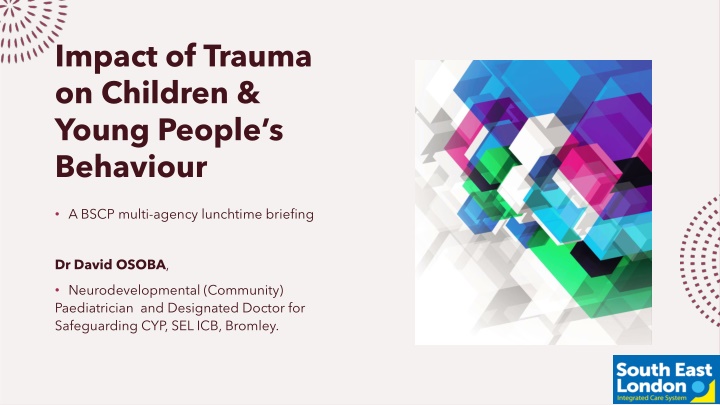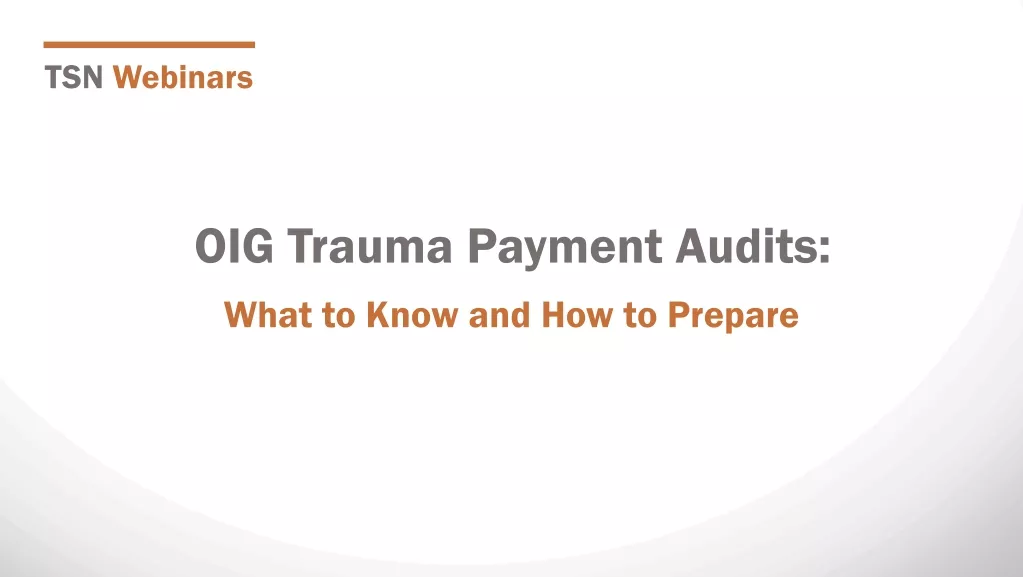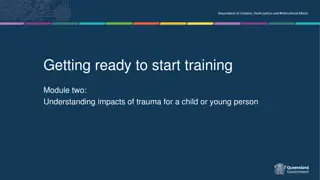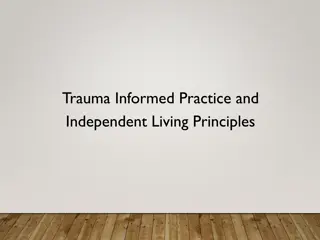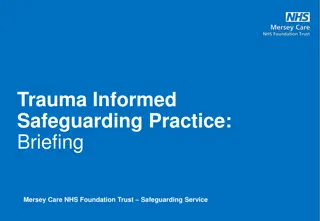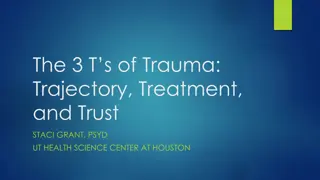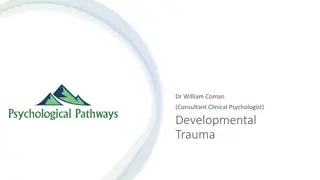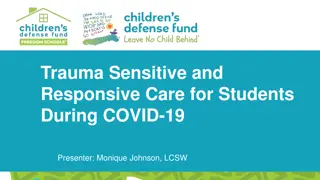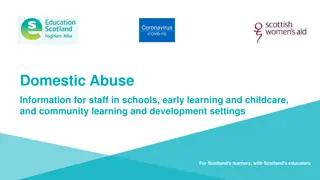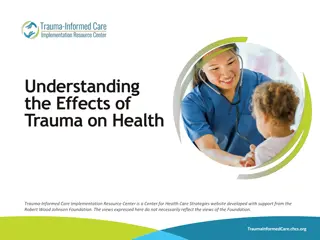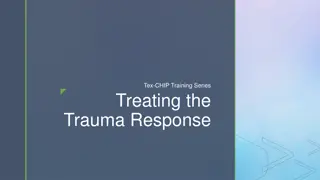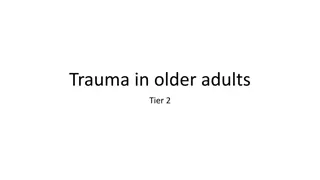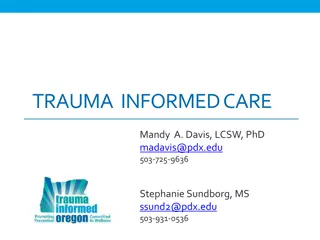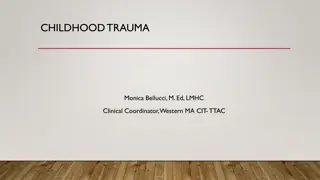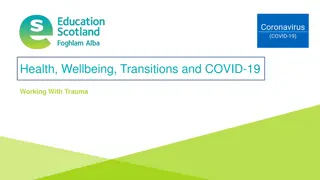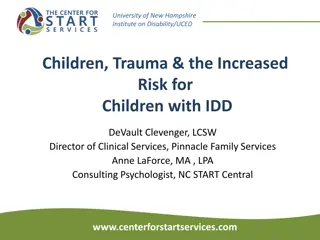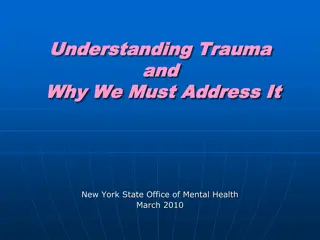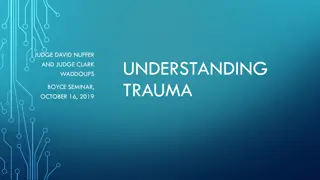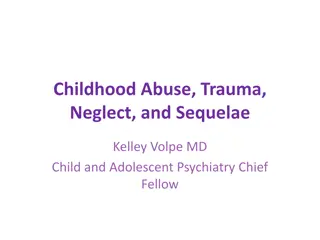Impact of Trauma on Children & Young People's Behavior
Trauma can have lasting adverse effects on individuals, affecting their behaviors and decision-making processes. Understanding stress responses, behavior loops, and presentations like Emotionally Unstable Personality Disorder is crucial. Resilience plays a key role in bouncing back from adversity.
Download Presentation

Please find below an Image/Link to download the presentation.
The content on the website is provided AS IS for your information and personal use only. It may not be sold, licensed, or shared on other websites without obtaining consent from the author.If you encounter any issues during the download, it is possible that the publisher has removed the file from their server.
You are allowed to download the files provided on this website for personal or commercial use, subject to the condition that they are used lawfully. All files are the property of their respective owners.
The content on the website is provided AS IS for your information and personal use only. It may not be sold, licensed, or shared on other websites without obtaining consent from the author.
E N D
Presentation Transcript
Impact of Trauma on Children & Young People s Behaviour A BSCP multi-agency lunchtime briefing Dr David OSOBA, Neurodevelopmental (Community) Paediatrician and Designated Doctor for Safeguarding CYP, SEL ICB, Bromley.
At the end of this briefing, Increased awareness of the impact of trauma (including Adverse Childhood Experiences) on behaviours and decision making, especially how a person rationalises. Understanding of stress responses, behaviour loops and Emotionally Unstable Personality Disorder (EUPD) presentation
Working definition of trauma-informed practice - Published 2 November 2022 Trauma results from an event, series of events, or set of circumstances that is experienced by an individual as harmful or life threatening. While unique to the individual, generally the experience of trauma can cause lasting adverse effects, limiting the ability to function and achieve mental, physical, social, emotional or spiritual well-being . https://www.gov.uk/government/publications/working-definition-of-trauma- informed-practice/working-definition-of-trauma-informed-practice
BPD / EUPD Engage in self-harm & other dangerous behaviours Difficulty returning their emotional level to a healthy / normal behaviours Struggle with a feeling of emptiness & fear of abandonment Risk factors: Family history, trauma, abuse (70%) Prognosis: with behaviour therapy, improves over time, with some cases in total remission by age 40 years
What is a Behaviour / Habit Loop ? This is the neuro-social system of building a habit (good or bad), by performing actions the same way frequently, and like muscle memory , the brain hardwires information about our responses. There is often a trigger that causes the routine of the behaviour to be repeated. There may or may not be a reward attached.
Resilience is the capacity to bounce back from adversity. Protective factors increase resilience, whereas risk factors increase vulnerability. Strengthening RESILIENCE Resilient individuals, families and communities are more able to deal with difficulties and adversities than those with less resilience. It is important that resilience is strengthened at both an individual and a societal level.
What do we mean by Trauma- informed practice? This is an approach to health and care interventions which is grounded in the understanding that trauma exposure can impact an individual's neurological, biological, psychological and social development, thus shaping a person s world view and relationship development.
After years of fight or flight, the nervous system is in a persistent parasympathetic state, and it needs the right environment and time to heal Trauma-informed approaches It is important to address the risk factors which make children and young people more vulnerable at an individual level but also in terms of the causes of wider risk factors in families and within a community.
Risk factors Protective factors Genetic or biological Perinatal trauma Early malnutrition Behavioural and learning difficulties Alcohol or substance misuse Traumatic brain injury Gender Healthy problem solving and emotional regulation skills School readiness Good communication skills Healthy social relationships Resilience Individual
Risk factors Protective factors Low family income Poor parenting and inconsistent discipline Family size Abuse (emotional, physical, sexual Emotional or physical neglect Household alcohol or substance misuse Household mental illness Family violence Family breakdown Household offending behaviour Stable home environments Nurturing and responsive relationships Strong and consistent parenting Frequent shared activities with parents Financial security and economic opportunities Relationships
Risk factors Protective factors Unsafe and violent communities Low social integration and poor social mobility Lack of possibilities for recreation Insufficient infrastructure for the satisfaction of needs and interests of young people Sense of belonging and connectedness Safe community environments Community cohesion Opportunities for sports and hobbies Community
Risk factors Protective factors Socio-economically deprived communities High unemployment Homelessness or poor housing Culture of violence, norms and values which accept, normalise or glorify violence or abuse Discrimination, racism, unconscious bias Difficulties in accessing services Good housing High standards of living Opportunities for valued social roles Society
Brain Builders: https://www.youtube.com/watch?v=LmVWOe1ky8s HPA axis / Stress Response: https://www.youtube.com/watch?v=QAeBKRaNri0 The Stress Response - Fight or Flight: https://www.youtube.com/watch?v=mtRrxNTnyh8 Relevant online videos - with links ACE resources: https://www.acesonlinelearning.com/resources Borderline Personality Disorder / EUPD: https://www.youtube.com/watch?v=IddZY44_-kg How childhood trauma affects health across a lifetime Nadine Burke Harris https://youtu.be/95ovIJ3dsNk How Toxic Stress impacts children s developing brains: https://www.youtube.com/watch?v=tIuVDLq3lLc
Original ACE Study: Am J Prev Med(1998) - V.J. Felitti et al. https://doi.org/10.1016/S0749-3797(98)00017-8 Karatekin, C., Hill, M. Expanding the Original Definition of Adverse Childhood Experiences (ACEs). Journ Child Adol Trauma 12, 289 306 (2019). https://doi.org/10.1007/s40653-018-0237-5 Wang, Y., Nerwen, R., & Gabris, C. (2019). Addressing adverse childhood experiences in diverse racial and ethnic settings: A review. Current Opinion in Pediatrics, 31(2), 284 289. https://doi.org/10.1097/MOP.0000000000000748 Relevant online articles - with links e-learning for healthcare: All Our Health: Vulnerabilities and trauma- informed practice Every Mind Matters Scottish Government (2020) Adverse Childhood Experiences (ACEs): https://www.gov.scot/publications/adverse-childhood- experiences-aces/ Risk factors associated with knife-crime in the United Kingdom among young peopleaged 10 24 years: a systematic review: https://bmcpublichealth.biomedcentral.com/counter/pdf/10.1186/s12889-020-09498-4.pdf Rise-up [Andra Day]: https://youtu.be/kNKu1uNBVkU
